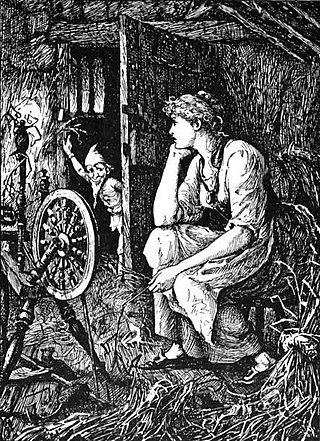
"Beauty and the Beast" is a fairy-tale written by French novelist Gabrielle-Suzanne Barbot de Villeneuve and published in 1740 in La Jeune Américaine et les contes marins.

The Tale of Tsar Saltan, of His Son the Renowned and Mighty Bogatyr Prince Gvidon Saltanovich and of the Beautiful Swan-Princess is an 1831 fairy tale in verse by Alexander Pushkin.

"The Twelve Dancing Princesses" is a German fairy tale collected by the Brothers Grimm and published in Grimm's Fairy Tales in 1815. It is of Aarne-Thompson type 306.

The Langs' Fairy Books are a series of 25 collections of true and fictional stories for children published between 1889 and 1913 by Andrew Lang and his wife, Leonora Blanche Alleyne. The best known books of the series are the 12 collections of fairy tales also known as Andrew Lang's "Coloured" Fairy Books or Andrew Lang's Fairy Books of Many Colors. In all, the volumes feature 798 stories, besides the 153 poems in The Blue Poetry Book.

"Bearskin" is a fairy tale collected by the Brothers Grimm. A variant from Sicily, "Don Giovanni de la Fortuna", was collected by Laura Gonzenbach in Sicilianische Märchen and included by Andrew Lang in The Pink Fairy Book. Italo Calvino included another Italian version, "The Devil's Breeches" from Bologna, in his Italian Folktales.

The Dancing Water, the Singing Apple, and the Speaking Bird is a Sicilian fairy tale collected by Giuseppe Pitrè, and translated by Thomas Frederick Crane for his Italian Popular Tales. Joseph Jacobs included a reconstruction of the story in his European Folk and Fairy Tales. The original title is "Li Figghi di lu Cavuliciddaru", for which Crane gives a literal translation of "The Herb-gatherer's Daughters".

The youngest son is a stock character in fairy tales, where he features as the hero. He is usually the third son, but sometimes there are more brothers, and sometimes he has only one; usually, they have no sisters.
The Grateful Beasts is a Hungarian fairy tale collected by Georg von Gaal in Mährchen der Magyaren (1822). The tale was also published by Hermann Kletke in Märchensaal, Vol II (1845).
"The Three Little Birds" is a German fairy tale collected by the Brothers Grimm, tale number 96. The story is originally written in Low German. It is Aarne-Thompson type 707, the dancing water, the singing apple, and the speaking bird. The story resembles Ancilotto, King of Provino, by Giovanni Francesco Straparola, and The Sisters Envious of Their Cadette, the story of the 756th night of the Arabian Nights.
The Bird 'Grip' is a Swedish fairy tale. Andrew Lang included it in The Pink Fairy Book. It is Aarne-Thompson type 550, the quest for the golden bird/firebird; other tales of this type include The Golden Bird, The Greek Princess and the Young Gardener, How Ian Direach got the Blue Falcon, The Nunda, Eater of People, and Tsarevitch Ivan, the Fire Bird and the Gray Wolf.
King Kojata or The Unlooked for Prince or Prince Unexpected is a Slavonic fairy tale, of Polish origin. Louis Léger remarked that its source was "one of the most important collections of Polish literature".

What came of picking Flowers is a Portuguese fairy tale first collected by Teophilo Braga with the name Cravo, Rosa e Jasmin. Andrew Lang included it in The Grey Fairy Book.
Prince Prigio is a literary and comic fairy tale written by Andrew Lang in 1889 and illustrated by Gordon Browne. It draws in Lang's folklorist background for many tropes.
The Gifts of the Magician is a Finnish fairy tale, first published by Eero Salmelainen. This tale, in particular, is actually titled Paholaisen antamat soittoneuwot [soittoneuvot]. It was translated into German by Emmy Schreck as Die Gaben des Unholds. Andrew Lang included it in The Crimson Fairy Book (1903), listing his source as Finnische Mahrchen.
The Golden-Haired Children is a Turkish fairy tale collected by folklorist Ignác Kúnos. It is related to the theme of the Calumniated Wife and is classified in the Aarne-Thompson-Uther Index as tale type ATU 707, "The Three Golden Children".

The Sisters who Envied Their Cadette is a fairy tale collected by French orientalist Antoine Galland and published in his translation of The Arabian Nights, a compilation of Arabic and Persian fairy tales.
The Children with the Golden Locks is a Georgian folktale. It is classified in the international Aarne-Thompson-Uther Index as type ATU 707, "The Three Golden Children".
The story of the Princess Arab-Zandīq or The Story of ‘Arab-Zandīq is a modern Egyptian folktale collected in the late 19th century by Guillaume Spitta Bey. It is related to the theme of the calumniated wife and classified in the international Aarne-Thompson-Uther Index as type ATU 707, "The Three Golden Children".
The Story of The Farmer's Three Daughters is an Icelandic fairy tale collected by author Jón Árnason in his 1864 compilation of Icelandic tales and legends. It is related to the theme of the calumniated wife and classified in the Aarne-Thompson-Uther Index as type ATU 707, "The Three Golden Children".
Little Nightingale the Crier is a Palestinian Arab folktale collected by scholars Ibrahim Muhawi and Sharif Kanaana. It is related to the theme of the calumniated wife and classified in the international Aarne-Thompson-Uther Index as type ATU 707, "The Three Golden Children".








